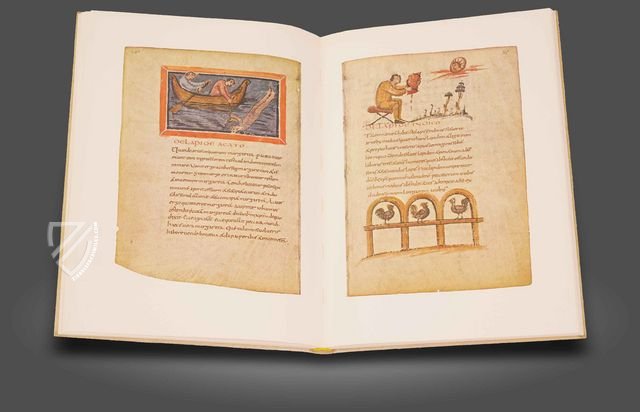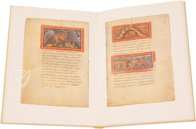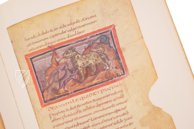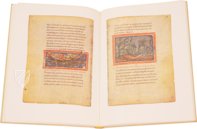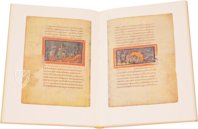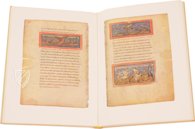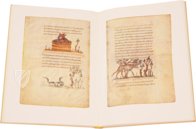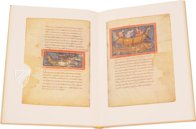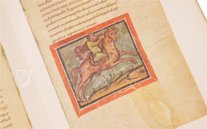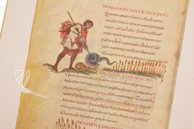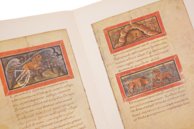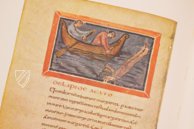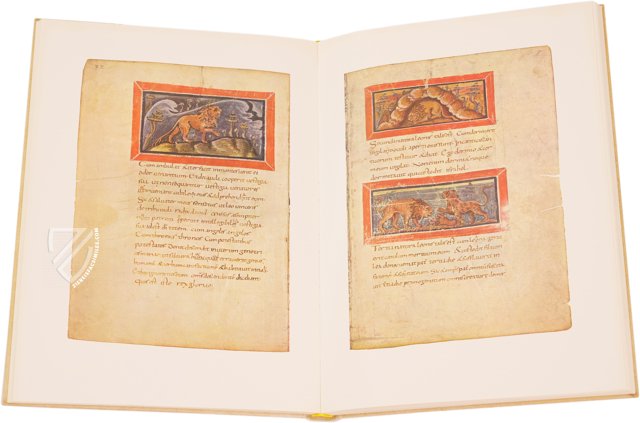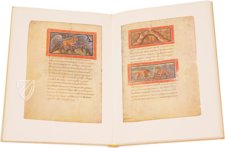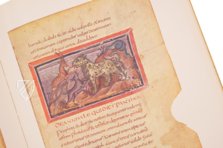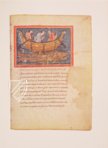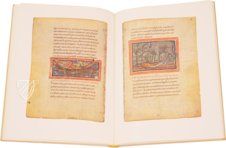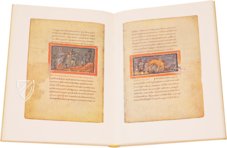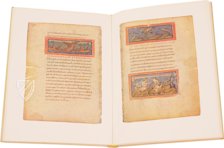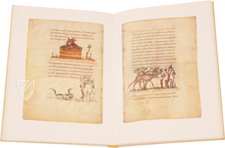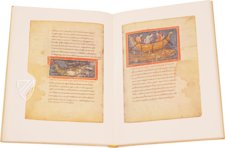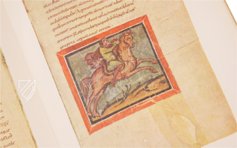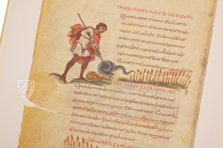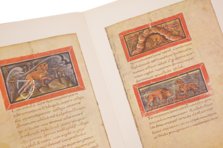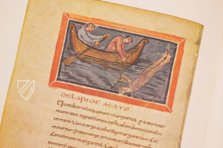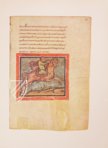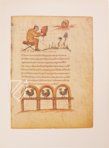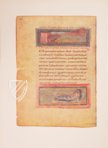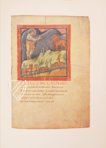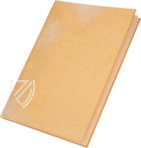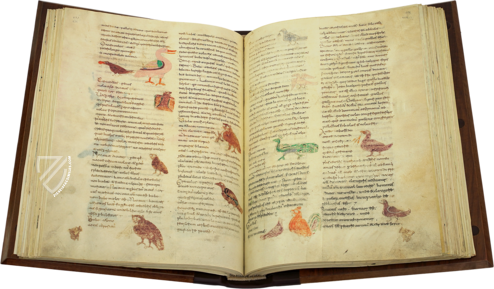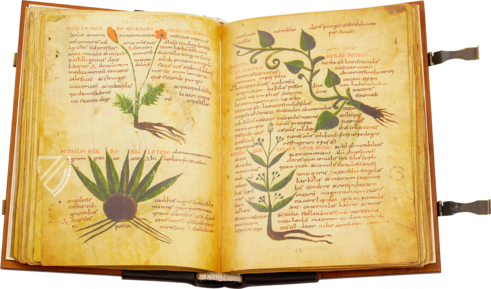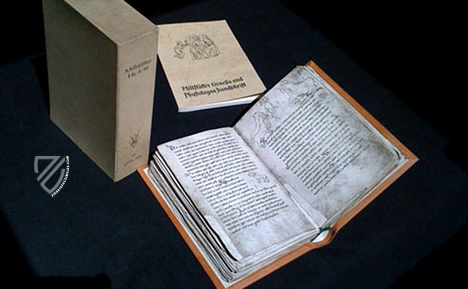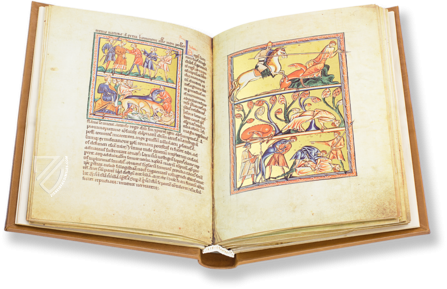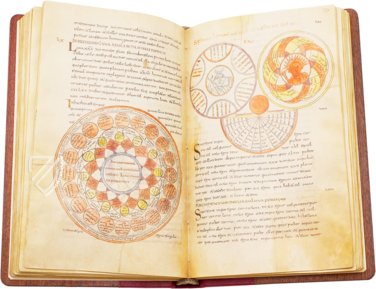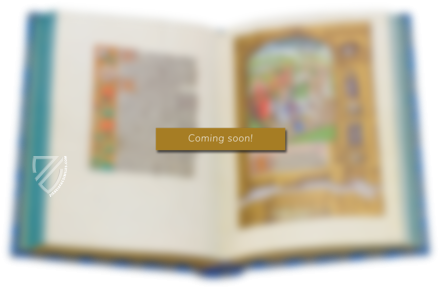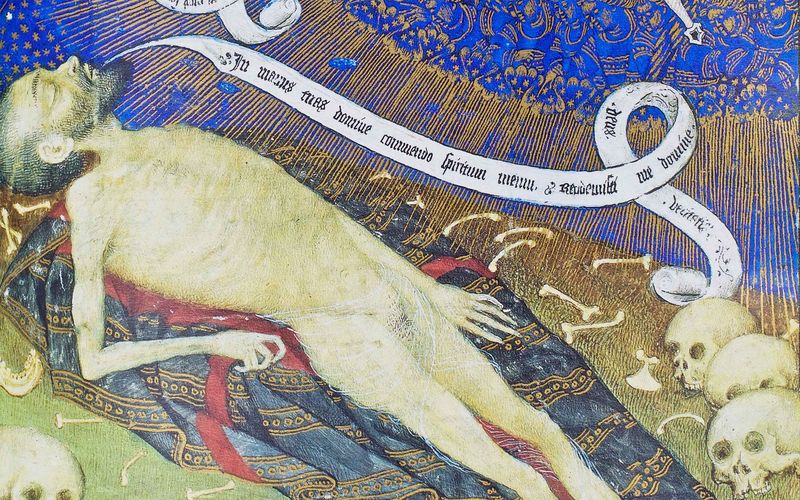Bern Physiologus
(under 1,000€)
The Bern Physiologus is a 9th century illuminated manuscript that appears to be a copy of a 5th century codex from Late Antiquity. It contains a Latin translation of the Physiologus, a didactic Christian text written or compiled in Greek by an unknown author in Alexandria sometime in the 2nd century. Originating in Hautvillers Abbey near Reims between 825 and 850, this Carolingian copy is the work of a scribe identified as Haecpertus and is very neatly written in Carolingian minuscule with uncial script in black and red for the headings. It covers topics ranging from saints’ lives to descriptions of various animals, plants, and stones with corresponding passages concerning their moral significance. 35 miniatures adorn the manuscript, 25 with frames and 10 without, which are integrated into the text in the manner of an ancient manuscript and are probably copies. The Bern Physiologus is the oldest known surviving copy of the work in any language, making it a precious specimen for modern researchers in numerous fields.
Bern Physiologus
The Physiologus is a didactic Christian text originally written in Greek during the 2nd century, which was very influential during the Middle Ages for the development of bestiaries – illustrated manuscripts depicting various animals and ascribing moral lessons to them. This type of Christian allegory was extremely popular and offers insights into the beliefs and worldview of medieval Europeans. The oldest surviving illustrated version of the text originated between 825 and 850 and is the work of a monk named Haecpertus in Hautvillers Abbey. Judging by the style of the fine miniatures that adorn the manuscript, it must be the copy of a late antique specimen. It has preserved 24 of the original 35–50 chapters, but also includes two new chapters on the horse and the rooster taken from works by Ambrose of Milan and Isidore of Seville. Most of the history of the manuscript is a mystery, it was likely in a monastic library for centuries before beingly privately owned in the 15th and 16th centuries and was finally acquired by the Burgerbibliothek Bern in 1632.
Understanding the Physiologus
This work is not an encyclopedia in the modern sense because it does not seek to scientifically describe and classify animals, plants, and minerals. Instead, it approaches nature as an assemblage of divine signs that are to be deciphered in order to draw moralistic lessons based on Biblical teachings. Although scientific and theological matters are generally divorced in the modern mind, there was nothing incongruous about this in the medieval mind, which saw them as parts of a holistic truth – God’s truth. As such, animals, plants, and minerals are not the subject of the work but rather devices whose specific natures serve to evoke moralizing lessons. Furthermore, fantastical creatures like dragons are included alongside frogs because it is their symbolic value that is important. Physiologus manuscripts were used as tools of religious education and were commonly found in monastic libraries but were also simple enough for educating the laity.
An Assortment of Moralizing Christian Texts
Each of the 26 chapters shares the same binary structure: a description of the animal (or in a few cases plant or stone) followed by a moralizing text explaining the significance of their nature, typically using an analogy from the Bible. Despite the Christian nature of the work, it draws from pagan traditions and corresponds strongly with Greco-Roman and Egyptian teachings. Aside from the primary text, the Carolingian manuscript also includes copies of the Life of Saint Simeon, the Chronicle of Fredegar, 18 short biographies of Christian patriarchs from Abraham to David, a pericope of the Gospel of Matthew with a Latin translation by Ephrem the Syrian, and more.
Decoration of the Work
It is debated whether Haecpertus, the scribe responsible for the work, was also the artist who pained its 35 colorful and handsome miniatures, most with a thick red frame bordered with a thinner black line. Regardless of the identity of the artist or artists, it is evident that the images were copied from a manuscript from Late Antiquity. Some scholars claim an Alexandrian origin as far back as the 4th century for this missing exemplar, others claim it could have been produced as late as the 8th century in a Greco-Italian artistic center of southern Italy. Either way, it is agreed that this ancient or not-so-ancient text made its way to Reims, which was becoming an influential center of artistic production. The attention to perspective and the naturalistic representation of the features, particularly the miniature on the first page depicting Jacob blessing the Lion of Judah, point to a skilled hand or hands. Thus, the work is precious not only because of its contents but for preserving the art of the ancient world.
Codicology
- Alternative Titles
- Berner Physiologus
Physiologus Bernensis
Codex Bongarsianus 318 - Size / Format
- 262 pages / 25.5 × 18.0 cm
- Origin
- France
- Date
- Ca. 830
- Epochs
- Style
- Language
- Script
- Carolingian Minuscule Uncial
- Illustrations
- 35 miniatures
#1 Physiologus Bernensis : voll-Faksimile-Ausg. des Codex Bongarsianus 318 der Burgerbibliothek Bern
Language: German
The commentary was included in a separate part of the facsimile volume.
(under 1,000€)
- Treatises / Secular Books
- Apocalypses / Beatus
- Astronomy / Astrology
- Bestiaries
- Bibles / Gospels
- Chronicles / History / Law
- Geography / Maps
- Saints' Lives
- Islam / Oriental
- Judaism / Hebrew
- Single Leaf Collections
- Leonardo da Vinci
- Literature / Poetry
- Liturgical Manuscripts
- Medicine / Botany / Alchemy
- Music
- Mythology / Prophecies
- Psalters
- Other Religious Books
- Games / Hunting
- Private Devotion Books
- Other Genres
- Afghanistan
- Armenia
- Austria
- Belgium
- Belize
- Bosnia and Herzegovina
- China
- Colombia
- Costa Rica
- Croatia
- Cyprus
- Czech Republic
- Denmark
- Egypt
- El Salvador
- Ethiopia
- France
- Germany
- Greece
- Guatemala
- Honduras
- Hungary
- India
- Iran
- Iraq
- Israel
- Italy
- Japan
- Jordan
- Kazakhstan
- Kyrgyzstan
- Lebanon
- Liechtenstein
- Luxembourg
- Mexico
- Morocco
- Netherlands
- Palestine
- Panama
- Peru
- Poland
- Portugal
- Romania
- Russia
- Serbia
- Spain
- Sri Lanka
- Sweden
- Switzerland
- Syria
- Tajikistan
- Turkey
- Turkmenistan
- Ukraine
- United Kingdom
- United States
- Uzbekistan
- Vatican City
- A. Oosthoek, van Holkema & Warendorf
- Aboca Museum
- Ajuntament de Valencia
- Akademie Verlag
- Akademische Druck- u. Verlagsanstalt (ADEVA)
- Aldo Ausilio Editore - Bottega d’Erasmo
- Alecto Historical Editions
- Alkuin Verlag
- Almqvist & Wiksell
- Amilcare Pizzi
- Andreas & Andreas Verlagsbuchhandlung
- Archa 90
- Archiv Verlag
- Archivi Edizioni
- Arnold Verlag
- ARS
- Ars Magna
- ArtCodex
- AyN Ediciones
- Azimuth Editions
- Badenia Verlag
- Bärenreiter-Verlag
- Belser Verlag
- Belser Verlag / WK Wertkontor
- Benziger Verlag
- Bernardinum Wydawnictwo
- BiblioGemma
- Biblioteca Apostolica Vaticana (Vaticanstadt, Vaticanstadt)
- Bibliotheca Palatina Faksimile Verlag
- Bibliotheca Rara
- Boydell & Brewer
- Bramante Edizioni
- Bredius Genootschap
- Brepols Publishers
- British Library
- C. Weckesser
- Caixa Catalunya
- Canesi
- CAPSA, Ars Scriptoria
- Caratzas Brothers, Publishers
- Carus Verlag
- Casamassima Libri
- Centrum Cartographie Verlag GmbH
- Chavane Verlag
- Christian Brandstätter Verlag
- Circulo Cientifico
- Club Bibliófilo Versol
- Club du Livre
- CM Editores
- Collegium Graphicum
- Collezione Apocrifa Da Vinci
- Comissão Nacional para as Comemorações dos Descobrimentos Portugueses
- Coron Verlag
- Corvina
- CTHS
- D. S. Brewer
- Damon
- De Agostini/UTET
- De Nederlandsche Boekhandel
- De Schutter
- Deuschle & Stemmle
- Deutscher Verlag für Kunstwissenschaft
- DIAMM
- Droz
- E. Schreiber Graphische Kunstanstalten
- Ediciones Boreal
- Ediciones Grial
- Ediclube
- Edições Inapa
- Edilan
- Editalia
- Edition Deuschle
- Edition Georg Popp
- Edition Leipzig
- Edition Libri Illustri
- Editiones Reales Sitios S. L.
- Éditions de l'Oiseau Lyre
- Editions Medicina Rara
- Editorial Casariego
- Editorial Mintzoa
- Editrice Antenore
- Editrice Velar
- Edizioni Edison
- Egeria, S.L.
- Eikon Editores
- Electa
- Emery Walker Limited
- Enciclopèdia Catalana
- Eos-Verlag
- Ephesus Publishing
- Ernst Battenberg
- Eugrammia Press
- Extraordinary Editions
- Fackelverlag
- Facsimila Art & Edition
- Facsimile Editions Ltd.
- Facsimilia Art & Edition Ebert KG
- Faksimile Verlag
- Feuermann Verlag
- Folger Shakespeare Library
- Franco Cosimo Panini Editore
- Friedrich Wittig Verlag
- Fundación Hullera Vasco-Leonesa
- G. Braziller
- Gabriele Mazzotta Editore
- Gebr. Mann Verlag
- Gesellschaft für graphische Industrie
- Getty Research Institute
- Giovanni Domenico de Rossi
- Giunti Editore
- Graffiti
- Grafica European Center of Fine Arts
- Guido Pressler
- Guillermo Blazquez
- Gustav Kiepenheuer
- H. N. Abrams
- Harrassowitz
- Harvard University Press
- Helikon
- Hendrickson Publishers
- Henning Oppermann
- Herder Verlag
- Hes & De Graaf Publishers
- Hoepli
- Holbein-Verlag
- Houghton Library
- Hugo Schmidt Verlag
- Idion Verlag
- Il Bulino, edizioni d'arte
- ILte
- Imago
- Insel Verlag
- Insel-Verlag Anton Kippenberger
- Instituto de Estudios Altoaragoneses
- Instituto Nacional de Antropología e Historia
- Introligatornia Budnik Jerzy
- Istituto dell'Enciclopedia Italiana - Treccani
- Istituto Ellenico di Studi Bizantini e Postbizantini
- Istituto Geografico De Agostini
- Istituto Poligrafico e Zecca dello Stato
- Italarte Art Establishments
- Jan Thorbecke Verlag
- Johnson Reprint Corporation
- Josef Stocker
- Josef Stocker-Schmid
- Jugoslavija
- Karl W. Hiersemann
- Kasper Straube
- Kaydeda Ediciones
- Kindler Verlag / Coron Verlag
- Kodansha International Ltd.
- Konrad Kölbl Verlag
- Kurt Wolff Verlag
- La Liberia dello Stato
- La Linea Editrice
- La Meta Editore
- Lambert Schneider
- Landeskreditbank Baden-Württemberg
- Leo S. Olschki
- Les Incunables
- Liber Artis
- Library of Congress
- Libreria Musicale Italiana
- Lichtdruck
- Lito Immagine Editore
- Lumen Artis
- Lund Humphries
- M. Moleiro Editor
- Maison des Sciences de l'homme et de la société de Poitiers
- Manuscriptum
- Martinus Nijhoff
- Maruzen-Yushodo Co. Ltd.
- MASA
- Massada Publishers
- McGraw-Hill
- Metropolitan Museum of Art
- Militos
- Millennium Liber
- Müller & Schindler
- Nahar - Stavit
- Nahar and Steimatzky
- National Library of Wales
- Neri Pozza
- Nova Charta
- Oceanum Verlag
- Odeon
- Orbis Mediaevalis
- Orbis Pictus
- Österreichische Staatsdruckerei
- Oxford University Press
- Pageant Books
- Parzellers Buchverlag
- Patrimonio Ediciones
- Pattloch Verlag
- PIAF
- Pieper Verlag
- Plon-Nourrit et cie
- Poligrafiche Bolis
- Presses Universitaires de Strasbourg
- Prestel Verlag
- Princeton University Press
- Prisma Verlag
- Priuli & Verlucca, editori
- Pro Sport Verlag
- Propyläen Verlag
- Pytheas Books
- Quaternio Verlag Luzern
- Reales Sitios
- Recht-Verlag
- Reichert Verlag
- Reichsdruckerei
- Reprint Verlag
- Riehn & Reusch
- Roberto Vattori Editore
- Rosenkilde and Bagger
- Roxburghe Club
- Salerno Editrice
- Saltellus Press
- Sandoz
- Sarajevo Svjetlost
- Schöck ArtPrint Kft.
- Schulsinger Brothers
- Scolar Press
- Scrinium
- Scripta Maneant
- Scriptorium
- Shazar
- Siloé, arte y bibliofilia
- SISMEL - Edizioni del Galluzzo
- Sociedad Mexicana de Antropología
- Société des Bibliophiles & Iconophiles de Belgique
- Soncin Publishing
- Sorli Ediciones
- Stainer and Bell
- Studer
- Styria Verlag
- Sumptibus Pragopress
- Szegedi Tudomànyegyetem
- Taberna Libraria
- Tarshish Books
- Taschen
- Tempus Libri
- Testimonio Compañía Editorial
- Thames and Hudson
- The Clear Vue Publishing Partnership Limited
- The Facsimile Codex
- The Folio Society
- The Marquess of Normanby
- The Richard III and Yorkist History Trust
- Tip.Le.Co
- TouchArt
- TREC Publishing House
- TRI Publishing Co.
- Trident Editore
- Tuliba Collection
- Typis Regiae Officinae Polygraphicae
- Union Verlag Berlin
- Universidad de Granada
- University of California Press
- University of Chicago Press
- Urs Graf
- Vallecchi
- Van Wijnen
- VCH, Acta Humaniora
- VDI Verlag
- VEB Deutscher Verlag für Musik
- Verlag Anton Pustet / Andreas Verlag
- Verlag Bibliophile Drucke Josef Stocker
- Verlag der Münchner Drucke
- Verlag für Regionalgeschichte
- Verlag Styria
- Vicent Garcia Editores
- W. Turnowski Ltd.
- W. Turnowsky
- Waanders Printers
- Wiener Mechitharisten-Congregation (Wien, Österreich)
- Wissenschaftliche Buchgesellschaft
- Wissenschaftliche Verlagsgesellschaft
- Wydawnictwo Dolnoslaskie
- Xuntanza Editorial
- Zakład Narodowy
- Zollikofer AG

